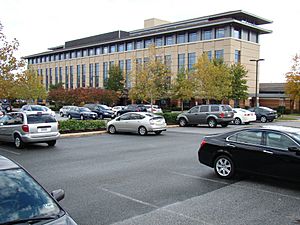J. Craig Venter Institute facts for kids
The J. Craig Venter Institute (JCVI) is a non-profit genomics research center. It was started by J. Craig Venter, Ph.D., in October 2006. This institute was formed by bringing together four different groups: the Center for the Advancement of Genomics, The Institute for Genomic Research (TIGR), the Institute for Biological Energy Alternatives, and the J. Craig Venter Science Foundation Joint Technology Center. JCVI has locations in Rockville, Maryland, and San Diego, California.
The institute studies not only genomics itself but also how genomics affects society. Their research includes genomic medicine, looking at genes in the environment, finding clean energy solutions, and synthetic biology. They also study the ethical, legal, and economic sides of these topics. More than 200 people work at the institute, including Nobel Prize winner Hamilton Smith. In 2022, the institute's San Diego facility was sold to the University of California, San Diego.
Contents
What is the History of the JCVI?
In 2004, several research groups joined together to create the J. Craig Venter Institute (JCVI). These groups included the Center for the Advancement of Genomics (TCAG), the Institute for Biological Energy Alternatives (IBEA), and the J. Craig Venter Institute Joint Technology Center (JTC).
How Did TIGR Start?
In 1992, Craig Venter was a scientist at the National Institutes of Health (NIH). Around that time, he started The Institute for Genomic Research (TIGR). TIGR played a part in mapping the entire set of human genes, known as the human genome. However, due to disagreements about how the project was being managed, TIGR stopped receiving money from the NIH in 1998. There were many notable disagreements between public and private science groups during this time.
What Genomes Did TIGR Sequence?
TIGR made important discoveries by sequencing the genes of many tiny living things.
- In 1997, TIGR mapped the genes of Borrelia burgdorferi, the bacteria that causes Lyme Disease.
- In 1998, they sequenced the genes of Treponema pallidum, another type of bacteria.
- In 1999, TIGR published the gene sequence of Deinococcus radiodurans. This is a special microbe that can survive very high levels of radiation.
- Overall, TIGR has sequenced and studied the genes of more than 50 different microbes.
- TIGR also created computer programs like GLIMMER to find genes and MUMmer to compare gene sequences.
- During the 2001 anthrax attacks, TIGR worked with the National Science Foundation and the FBI. They helped sequence the specific type of Bacillus anthracis bacteria used in the attacks.
What Other Institutes Did Venter Create?
In June 2000, Venter started The Center for the Advancement of Genomics (TCAG). This group was a "think tank" that studied the ethical questions around human genetics and stem cells research.
In 2002, Venter also founded the Institute for Biological Energy Alternatives (IBEA). IBEA looked into using tiny organisms to make alternative fuels, like hydrogen. They also studied how to capture carbon dioxide from the air. IBEA began mapping the genes of microbes found in the environment that might be useful for these goals.
To support these research centers, Venter created the J. Craig Venter Institute Joint Technology Center (JTC). This center focused on high throughput sequencing, which means sequencing many genes very quickly. To manage the money and operations for TIGR, TCAG, IBEA, and JTC, Venter set up the non-profit J. Craig Venter Science Foundation (JCVSF). This foundation helped bring all the activities of these groups together.
What Were Some Major Discoveries at JCVI?
In 2007, the institute published the first complete human genome from a single person. This was J. Craig Venter's own genome. It included both sets of chromosomes, showing all the genetic information.
In 2010, the institute mapped the 1.08 million base pair genome of Mycoplasma mycoides. They then put this synthetic (man-made) genome into a cell. This created the first cell with a completely artificial set of genes.
What Happened to the La Jolla Facility?
In April 2022, Venter sold the La Jolla facility in San Diego to the University of California, San Diego. The sale was for $25 million. The university already has a strong genomics program. They plan to welcome most of the institute's scientists and their current research projects. Craig Venter will continue to lead a separate non-profit research group, also called the J. Craig Venter Institute.
See also
- Artificial cell
- The Institute for Genomic Research
- Global Ocean Sampling Expedition
- Mycoplasma laboratorium
- Synthetic mycoides



